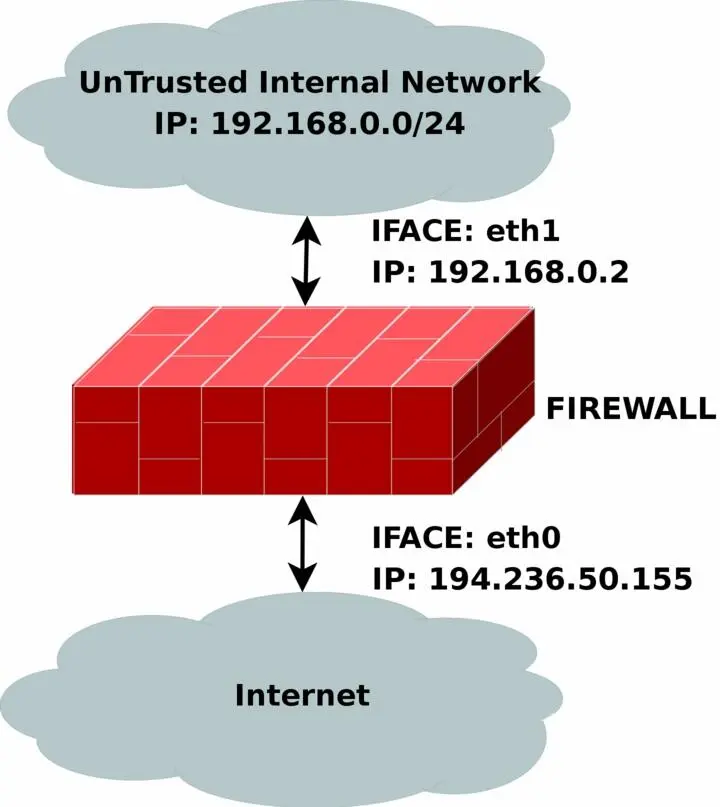Oskar Andreasson - Iptables Tutorial 1.2.2
- Название:Iptables Tutorial 1.2.2
- Автор:
- Жанр:
- Издательство:неизвестно
- Год:неизвестен
- ISBN:нет данных
- Рейтинг:
- Избранное:Добавить в избранное
-
Отзывы:
-
Ваша оценка:
Oskar Andreasson - Iptables Tutorial 1.2.2 краткое содержание
Iptables Tutorial 1.2.2 - читать онлайн бесплатно полную версию (весь текст целиком)
Интервал:
Закладка:
• CONFIG_NETFILTER
• CONFIG_IP_NF_CONNTRACK
• CONFIG_IP_NF_IPTABLES
• CONFIG_IP_NF_MATCH_LIMIT
• CONFIG_IP_NF_MATCH_STATE
• CONFIG_IP_NF_FILTER
• CONFIG_IP_NF_NAT
• CONFIG_IP_NF_TARGET_LOG
You need to have two internal networks with this script as you can see from the picture. One uses IP range 192.168.0.0/24 and consists of a Trusted Internal Network. The other one uses IP range 192.168.1.0/24 and consists of the De-Militarized Zone which we will do 1-to-1 NAT to. For example, if someone from the Internet sends a packet to our DNS_IP, then we use DNAT to send the packet on to our DNS on the DMZ network. When the DNS sees our packet, the packet will be destined for the actual DNS internal network IP, and not to our external DNS IP. If the packet would not have been translated, the DNS wouldn't have answered the packet. We will show a short example of how the DNAT code looks:
$IPTABLES -t nat -A PREROUTING -p TCP -i $INET_IFACE -d $DNS_IP \
--dport 53 -j DNAT --to-destination $DMZ_DNS_IP
First of all, DNAT can only be performed in the PREROUTING chain of the nat table. Then we look for TCP protocol on our $INET_IFACE with destination IP that matches our $DNS_IP, and is directed to port 53, which is the TCP port for zone transfers between name servers. If we actually get such a packet we give a target of DNAT. After that we specify where we want the packet to go with the --to-destination option and give it the value of $DMZ_DNS_IP, in other words the IP of the DNS on our DMZ network. This is how basic DNAT works. When the reply to the DNATed packet is sent through the firewall, it automatically gets un-DNATed.
By now you should have enough understanding of how everything works to be able to understand this script pretty well without any huge complications. If there is something you don't understand that hasn't been gone through in the rest of the tutorial, mail me since it is probably a fault on my side.
rc.DHCP.firewall.txt

The rc.DHCP.firewall.txtscript is pretty much identical to the original rc.firewall.txt . However, this script no longer uses the STATIC_IP variable, which is the main change to the original rc.firewall.txt script. The reason is that this won't work together with a dynamic IP connection. The actual changes needed to be done to the original script are minimal, however, I've had some people mail me and ask about the problem so this script will be a good solution for you. This script will allow people who uses DHCP, PPP and SLIP connections to connect to the Internet.
The rc.DHCP.firewall.txt script requires the following options to be compiled statically to the kernel, or as modules, as a bare minimum to run properly.
• CONFIG_NETFILTER
• CONFIG_IP_NF_CONNTRACK
• CONFIG_IP_NF_IPTABLES
• CONFIG_IP_NF_MATCH_LIMIT
• CONFIG_IP_NF_MATCH_STATE
• CONFIG_IP_NF_FILTER
• CONFIG_IP_NF_NAT
• CONFIG_IP_NF_TARGET_MASQUERADE
• CONFIG_IP_NF_TARGET_LOG
The main changes done to the script consist of erasing the STATIC_IP variable as I already said and deleting all references to this variable. Instead of using this variable the script now does its main filtering on the variable INET_IFACE. In other words -d $STATIC_IP has been changed to -i $INET_IFACE. This is pretty much the only change made and that's all that's needed really.
There are some more things to think about though. We can no longer filter in the INPUT chain depending on, for example, --in-interface $LAN_IFACE --dst $INET_IP. This in turn forces us to filter only based on interfaces in such cases where the internal machines must access the Internet addressable IP. One great example is if we are running an HTTP on our firewall. If we go to the main page (i.e., http://192.168.0.1/), which contains static links back to the same host (i.e., http://foobar.dyndns.net/fuubar.html), which could be some dyndns solution, we would get a minor problem. The NATed box would ask the DNS for the IP of the HTTP server, then try to access that IP. In case we filter based on interface and IP, the NATed box would be unable to get to the HTTP because the INPUT chain would DROP the packets flat to the ground. This also applies in a sense to the case where we got a static IP, but in such cases it could be gotten around by adding rules which check the LAN interface packets for our INET_IP, and if so ACCEPT them.
As you may read from above, it may be a good idea to get a script, or write one, that handles dynamic IP in a better sense. We could for example make a script that grabs the IP from ifconfig and adds it to a variable, upon boot-up of the Internet connection. A good way to do this, would be to use, for example, the ip-up scripts provided with pppd and some other programs. For a good site, check out the linuxguruz.org iptables site which has a huge collection of scripts available to download. You will find a link to the linuxguruz.org site from the Other resources and links appendix.
Note This script might be a bit less secure than the rc.firewall.txt script. I would definitely advise you to use that script if at all possible since this script is more open to attacks from the outside.
Also, there is the possibility to add something like this to your scripts:
INET_IP=`ifconfig $INET_IFACE | grep inet | cut -d : -f 2 | \
cut -d ' ' -f 1`
The above would automatically grab the IP address of the $INET_IFACE variable, grep the correct line which contains the IP address and then cuts it down to a manageable IP address. For a more elaborate way of doing this, you could apply the snippets of code available within the retreiveip.txtscript, which will automatically grab your Internet IP address when you run the script. Do note that this may in turn lead to a little bit of "weird" behavior, such as stalling connections to and from the firewall on the internal side. The most common strange behaviors are described in the following list.
If the script is run from within a script which in turn is executed by, for example, the PPP daemon, it will hang all currently active connections due to the NEW not SYN rules (see the State NEW packets but no SYN bit set section). It is possible to get by, if you get rid of the NEW not SYN rules for example, but it is questionable.
If you got rules that are static and always want to be around, it is rather harsh to add and erase rules all the time, without hurting the already existing ones. For example, if you want to block hosts on your LAN to connect to the firewall, but at the same time operate a script from the PPP daemon, how would you do it without erasing your already active rules blocking the LAN?
It may get unnecessarily complicated, as seen above which, in turn, could lead to security compromises. If the script is kept simple, it is easier to spot problems, and to keep order in it.
rc.UTIN.firewall.txt

The rc.UTIN.firewall.txtscript will in contrast to the other scripts block the LAN that is sitting behind us. In other words, we don't trust anyone on any networks we are connected to. We also disallow people on our LAN to do anything but specific tasks on the Internet. The only things we actually allow are POP3, HTTP and FTP access to the Internet. We also don't trust the internal users to access the firewall more than we trust users on the Internet.
The rc.UTIN.firewall.txt script requires the following options to be compiled statically to the kernel, or as modules. Without one or more of these, the script will become more or less flawed since parts of the script's required functionalities will be unusable. As you change the script you use, you could possibly need more options to be compiled into your kernel depending on what you want to use.
• CONFIG_NETFILTER
• CONFIG_IP_NF_CONNTRACK
• CONFIG_IP_NF_IPTABLES
• CONFIG_IP_NF_MATCH_LIMIT
• CONFIG_IP_NF_MATCH_STATE
• CONFIG_IP_NF_FILTER
• CONFIG_IP_NF_NAT
• CONFIG_IP_NF_TARGET_LOG
This script follows the golden rule to not trust anyone, not even our own employees. This is a sad fact, but a large part of the hacks and cracks that a company gets hit by are a matter of people from their own staff perpetrating the hit. This script will hopefully give you some clues as to what you can do with your firewall to strengthen it. It's not very different from the original rc.firewall.txt script, but it does give a few hints at what we would normally let through etc.
rc.test-iptables.txt
The rc.test-iptables.txtscript can be used to test all the different chains, but it might need some tweaking depending on your configuration, such as turning on ip_forwarding, and setting up masquerading etc. It will work for most everyone who has all the basic set up and all the basic tables loaded into kernel. All it really does is set some LOG targets which will log ping replies and ping requests. This way, you will get information on which chain was traversed and in which order. For example, run this script and then do:
ping -c 1 host.on.the.internet
And tail -n 0 -f /var/log/messages while doing the first command. This should show you all the different chains used, and in which order, unless the log entries are swapped around for some reason.
NoteThis script was written for testing purposes only. In other words, it's not a good idea to have rules like this that log everything of one sort since your log partitions might get filled up quickly and it would be an effective Denial of Service attack against you and might lead to real attacks on you that would be unlogged after the initial Denial of Service attack.
rc.flush-iptables.txt
The rc.flush-iptables.txtscript should not really be called a script in itself. The rc.flush-iptables.txtscript will reset and flush all your tables and chains. The script starts by setting the default policies to ACCEPT on the INPUT, OUTPUT and FORWARD chains of the filter table. After this we reset the default policies of the PREROUTING, POSTROUTING and OUTPUT chains of the nat table. We do this first so we won't have to bother about closed connections and packets not getting through. This script is intended for actually setting up and troubleshooting your firewall, and hence we only care about opening the whole thing up and resetting it to default values.
After this we flush all chains first in the filter table and then in the NAT table. This way we know there are no redundant rules lying around anywhere. When all of this is done, we jump down to the next section where we erase all the user specified chains in the NAT and filter tables. When this step is done, we consider the script done. You may consider adding rules to flush your mangle table if you use it.
NoteOne final word on this issue. Certain people have mailed me asking me to put this script into the original rc.firewall script using Red Hat Linux syntax where you type something like rc.firewall start and the script starts. However, I will not do that since this is a tutorial and should be used as a place to fetch ideas mainly and it shouldn't be filled up with shell scripts and strange syntax. Adding shell script syntax and other things makes the script harder to read as far as I am concerned and the tutorial was written with readability in mind and will continue being so.
Читать дальшеИнтервал:
Закладка:










